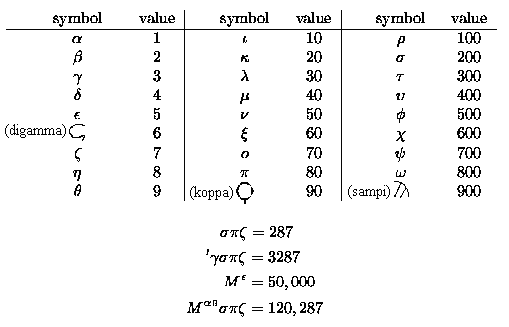
Greek mathematical notation was not positional; it utilized many symbols and was cumbersome to work with.

The "M" is a myriad, and
represents 10,000. The Greek work is murious (uncountable,
pl. murioi). The Romans converted to this to myriad.
The Sand Reckoner is a remarkable work in which Archimedes proposes a number system
that uses powers of a myriad myriad (base 100,000,000) and is capable of expressing numbers up
to 8 x 1063 in modern notation.
He argues in this work that this number is large enough to count the number of grains of sand
which could be fitted into the universe.
"There are some, King Gelon, who think that the number of the sand is infinite in multitude; and I mean by the sand not only that which exists about Syracuse and the rest of Sicily but also that which is found in every region whether inhabited or uninhabited."
"Aristarchus of Samos brought out a book consisting of some hypotheses, in which the premises lead to the result that the universe is many times greater than that now so called. His hypotheses are that the fixed stars and the sun remain unmoved, that the earth revolves about the sun in the circumference of a circle, the sun lying in the middle of the orbit, and that the sphere of the fixed stars, situated about the same center as the sun, is so great that the circle in which he supposes the earth to revolve bears such a proportion to the distance of the fixed stars as the center of the sphere bears to its surface."
Archimedes took Aristarchus to mean that the ratio of the size of the earth to the size of the universe is comparable to that of the orbit of the earth compared to the sphere of stars.
"One can also show that the diameter of the universe is less than a line equal to a myriad diameters of the earth and that, moreover, the diameter of the universe is less than a line equal to one hundred myriad myriad stadia [~ 6 x 1012 ft, between Saturn and Uranus]. As soon as one has accepted the fact that the diameter of the sun is not greater than thirty moon diameters and that the diameter of the earth is greater than the diameter of the moon, it is clear that the diameter of the sun is less than thirty diameters of the earth."
This was a huge leap over previous estimates of the size of the universe! Archimedes was the first person to think on the scale of modern astronomy.
". . . this number is the eighth of the eight numbers, which is one thousand
myriads of eight numbers. . . . It is therefore obvious that the number of grains of sand filling a sphere of the size that Aristarchus lends to the sphere of fixed stars is less than one thousand myriad myriad eighth numbers."This is Archimedes' estimate of the 8 x 1063 grains of sand to fill the universe.